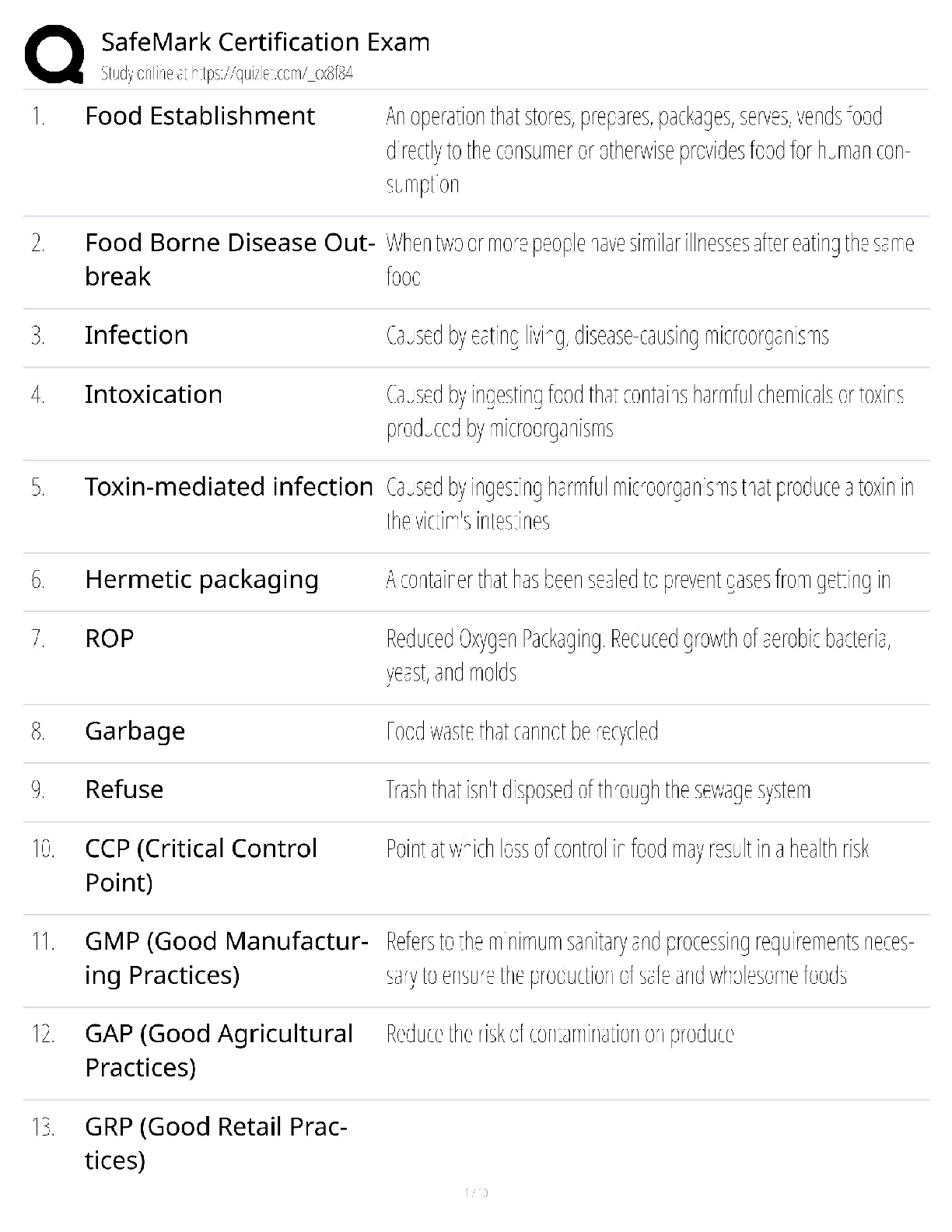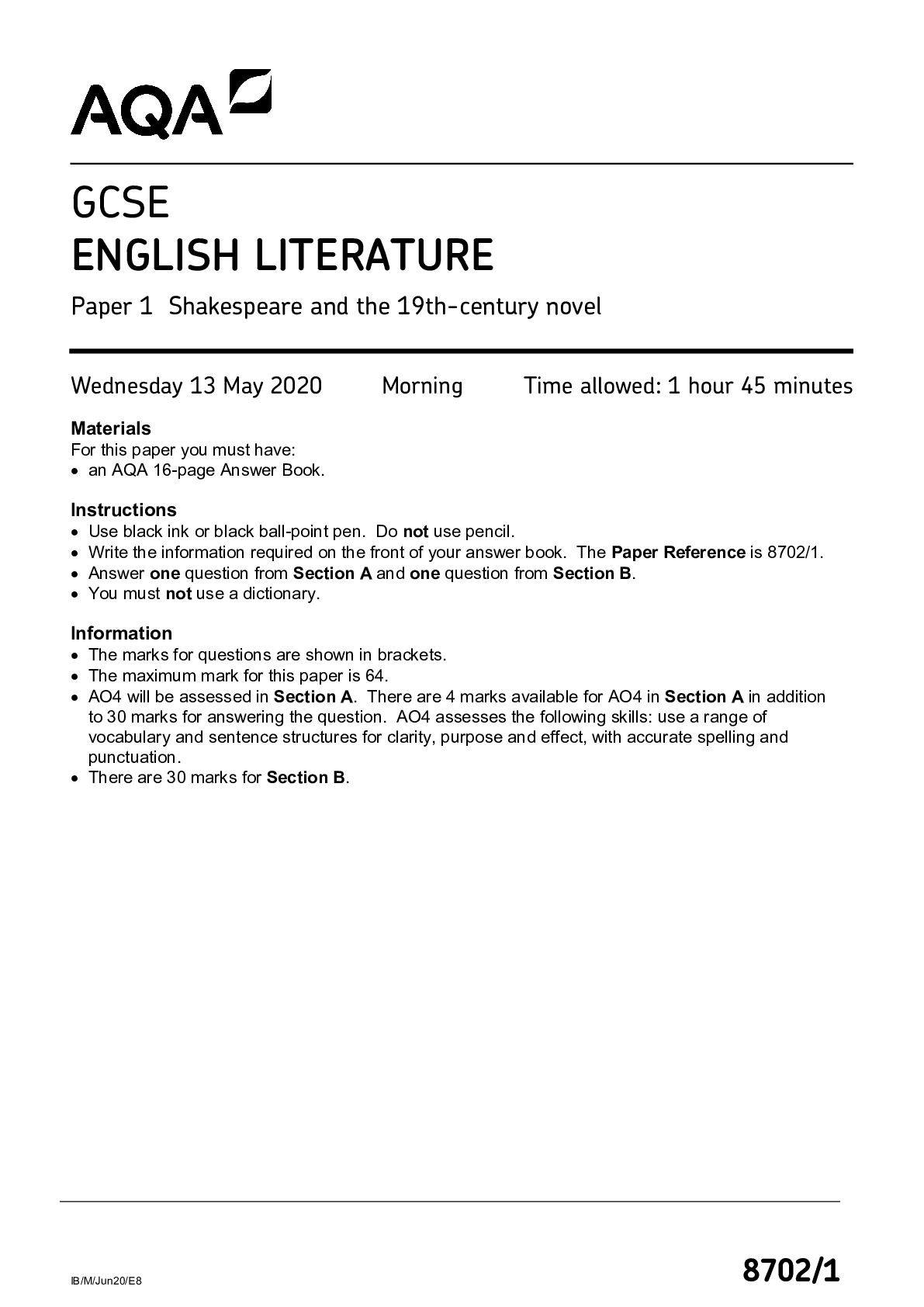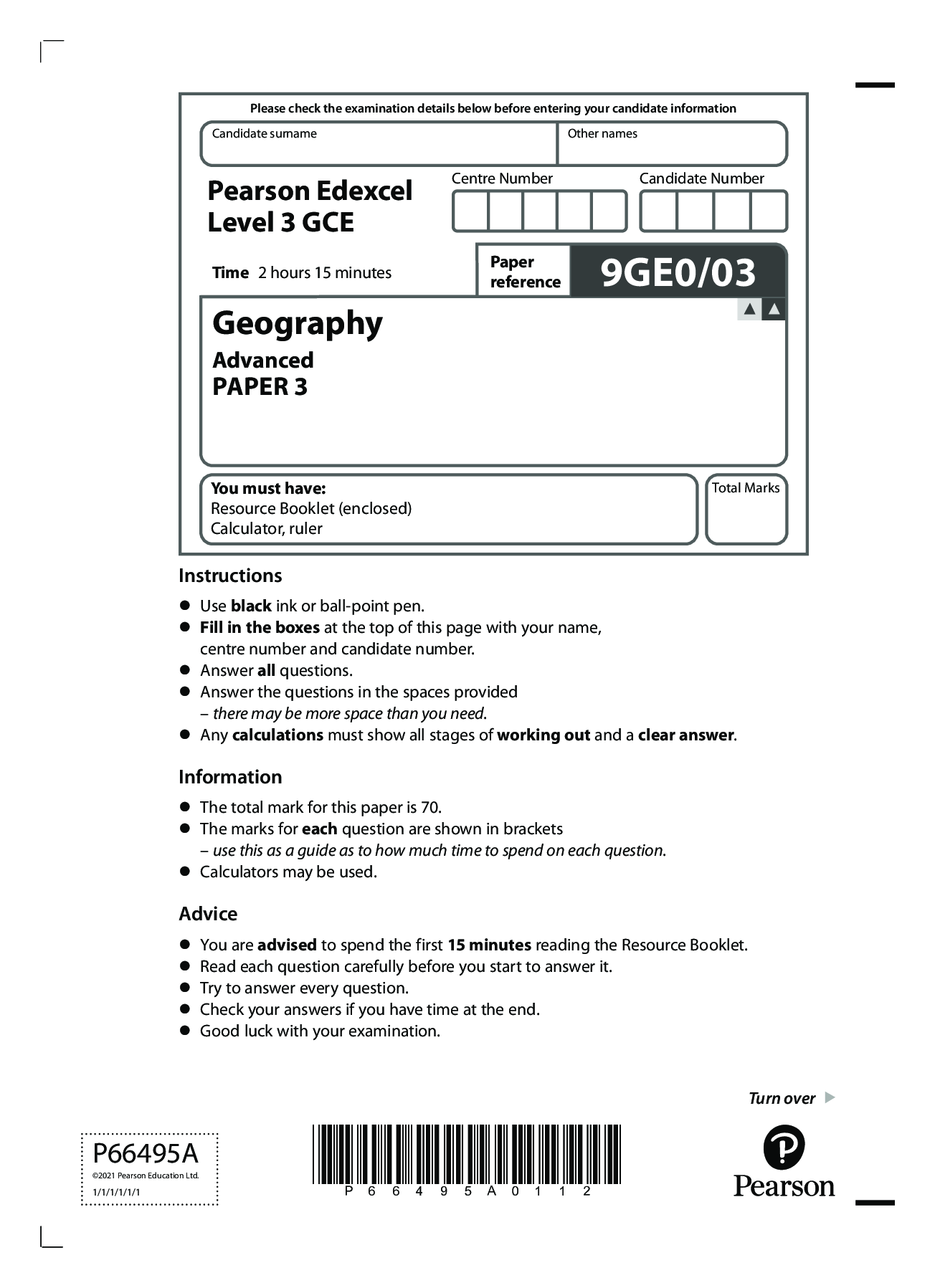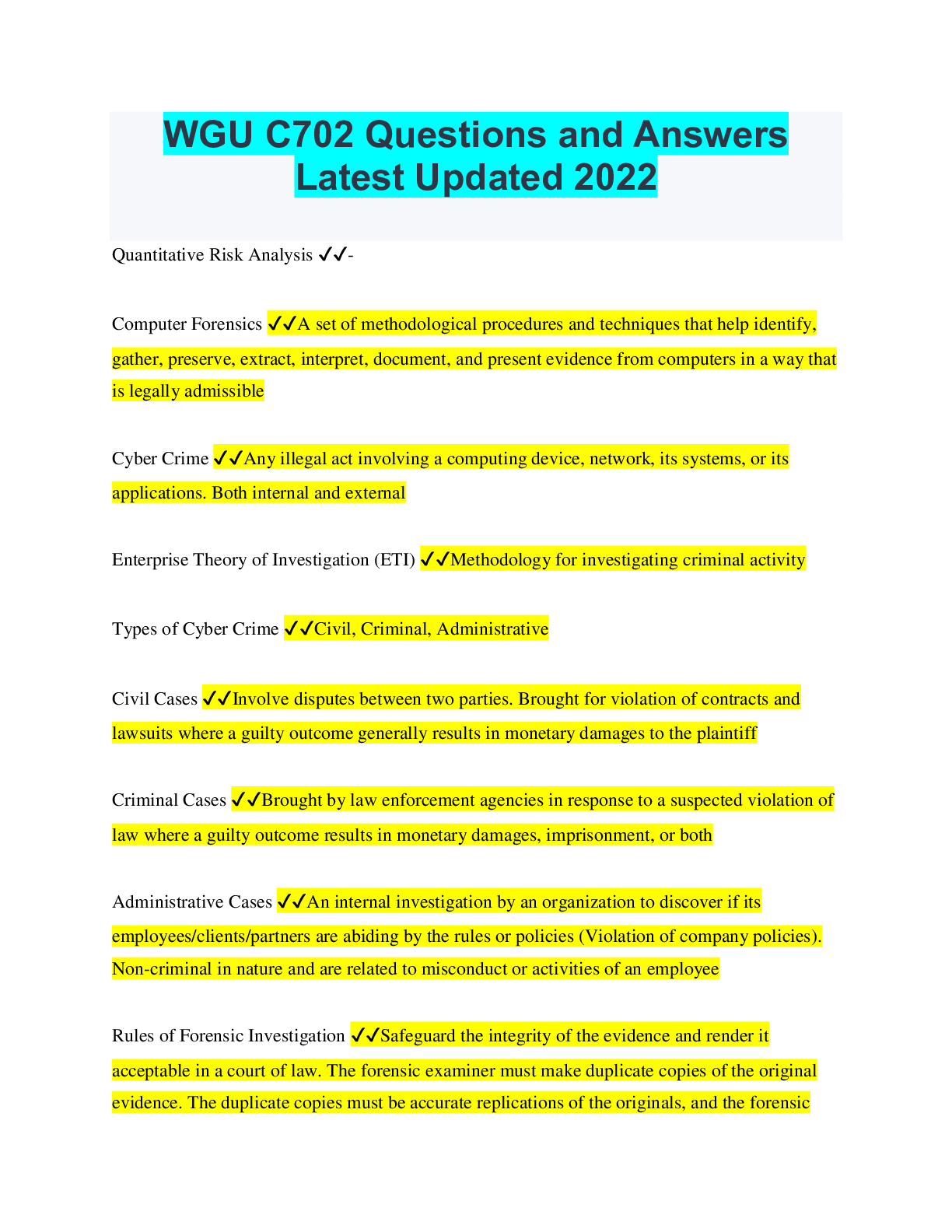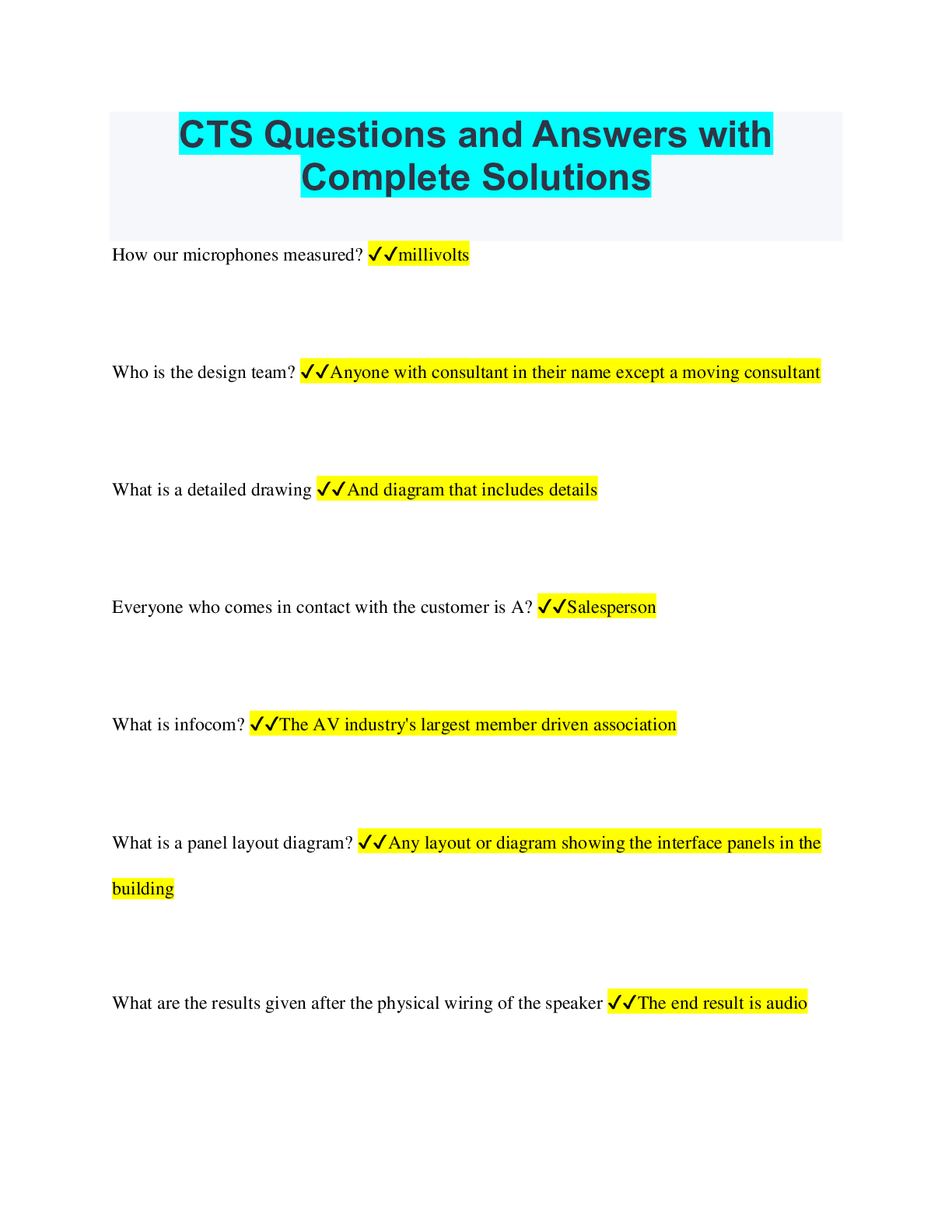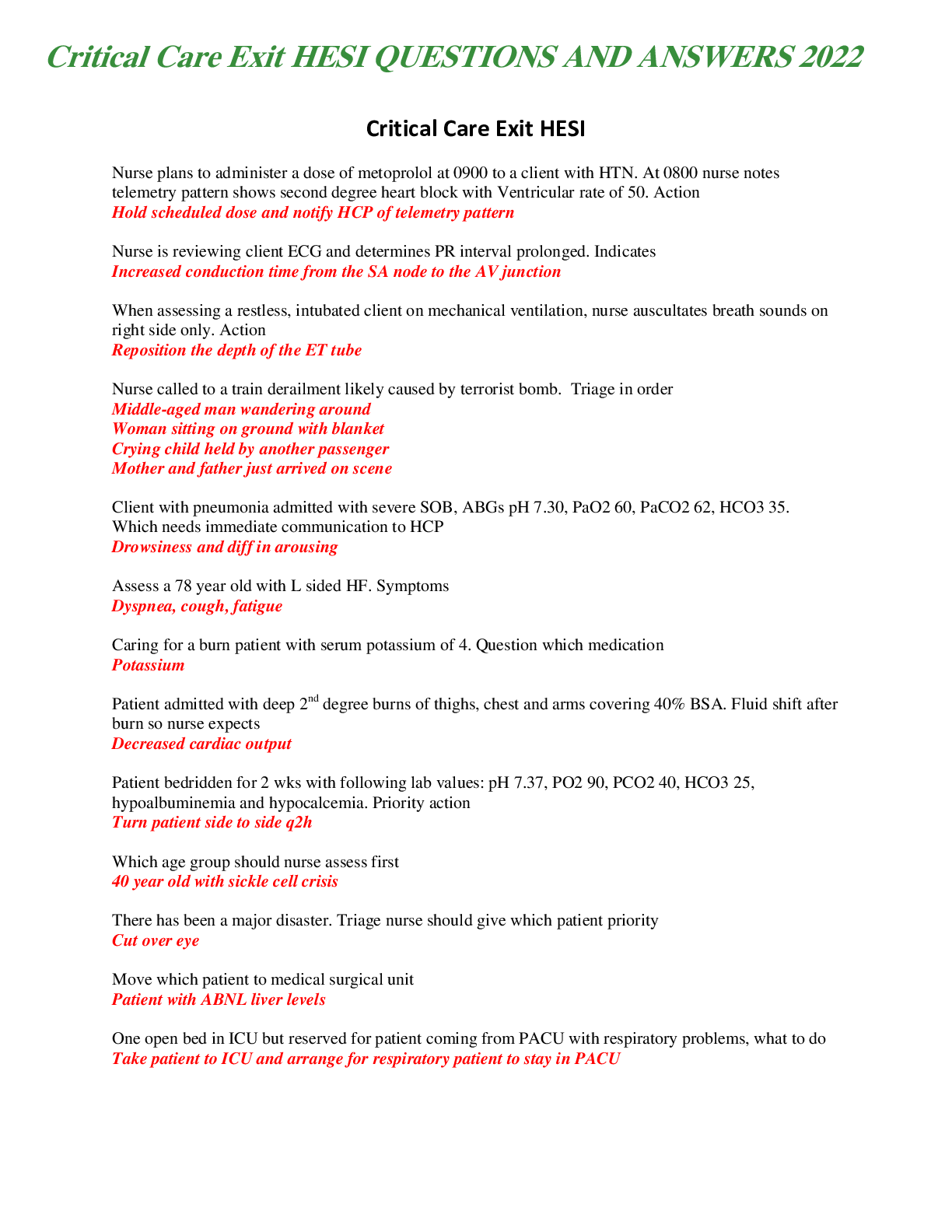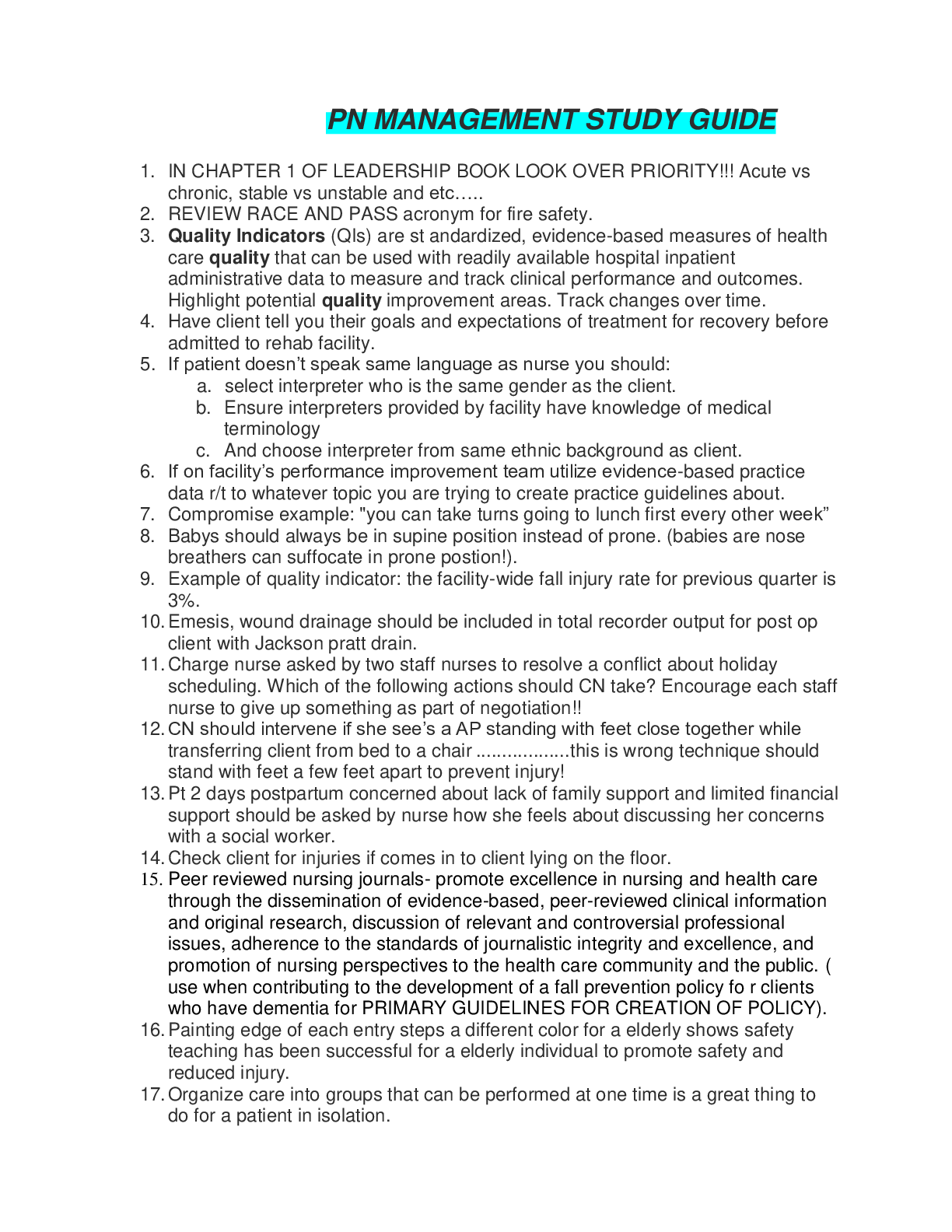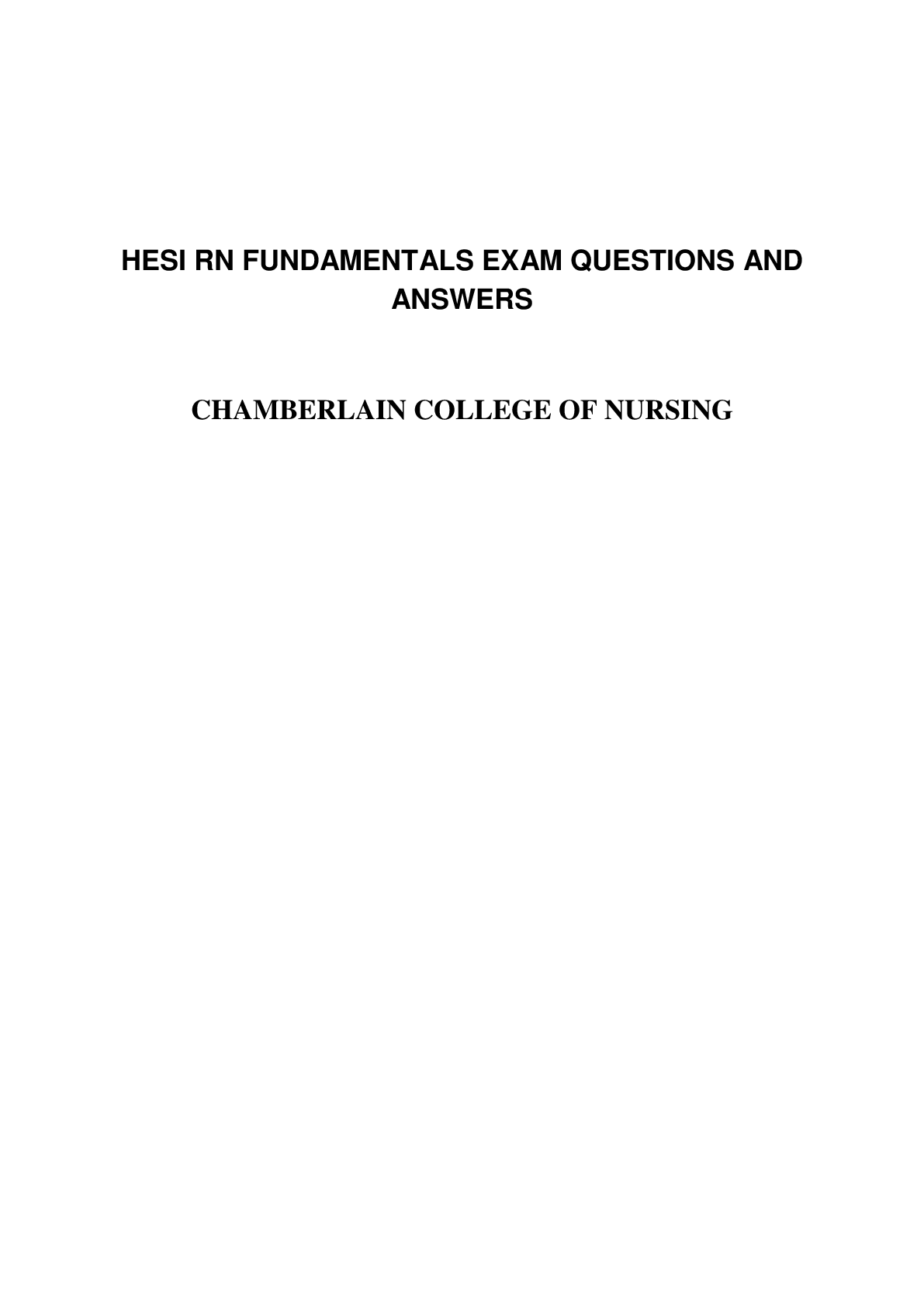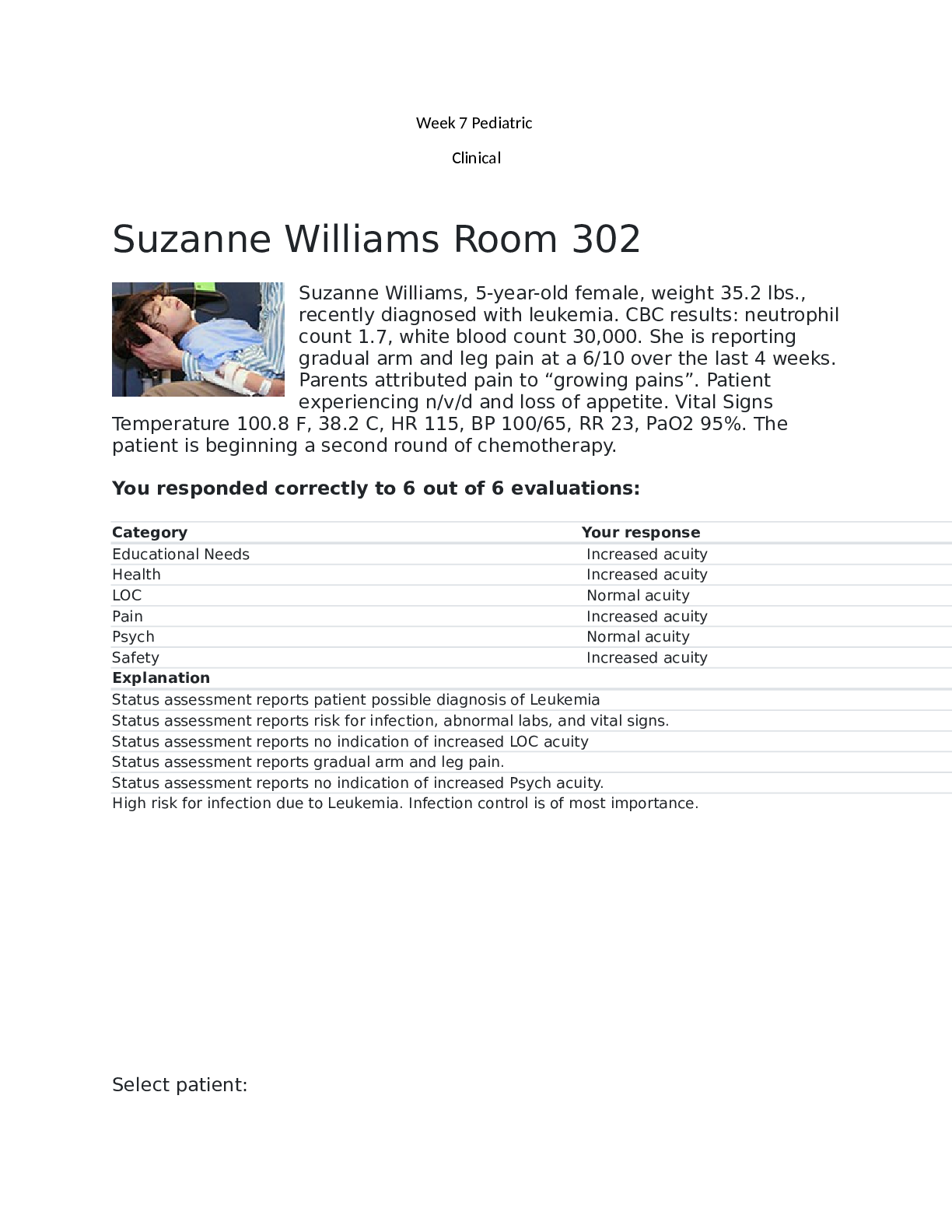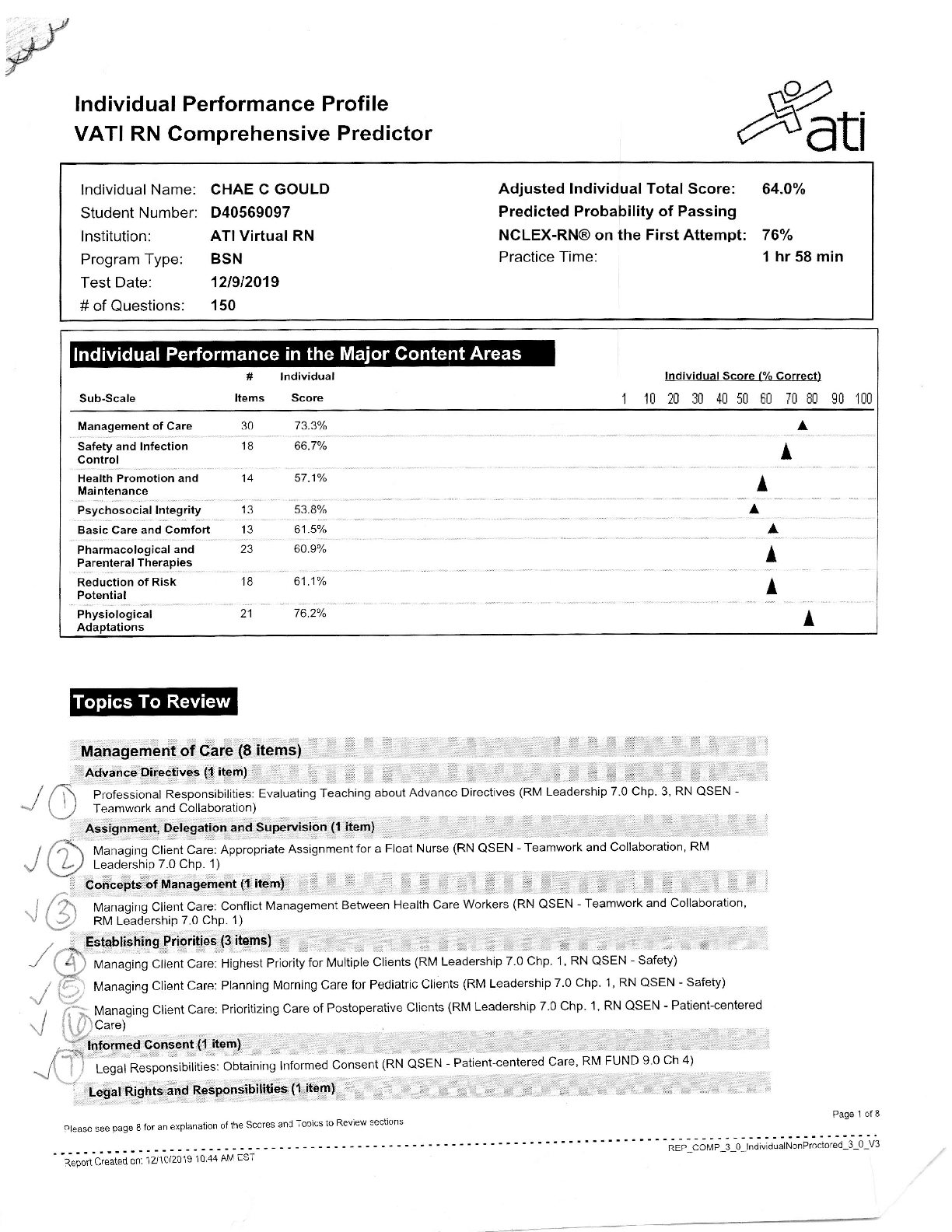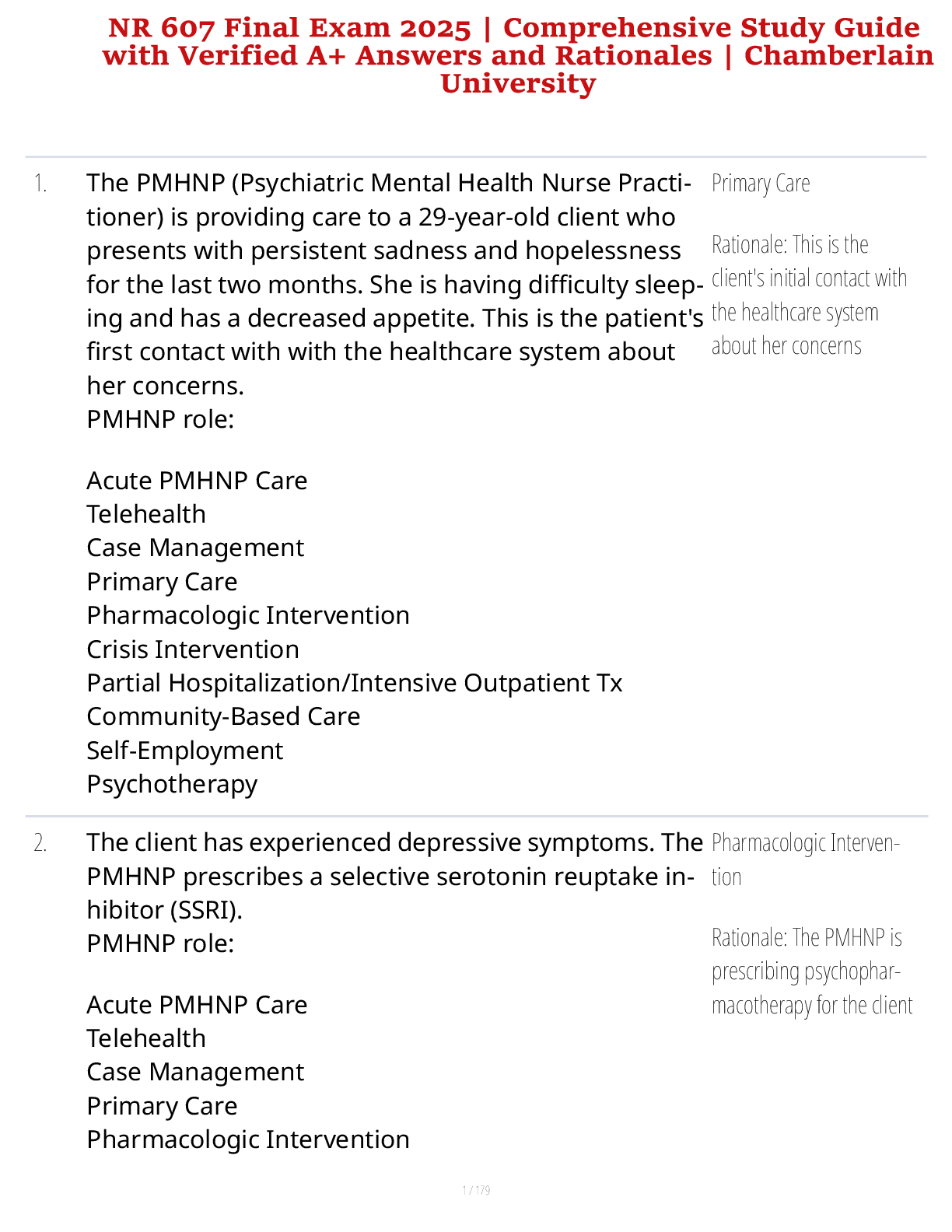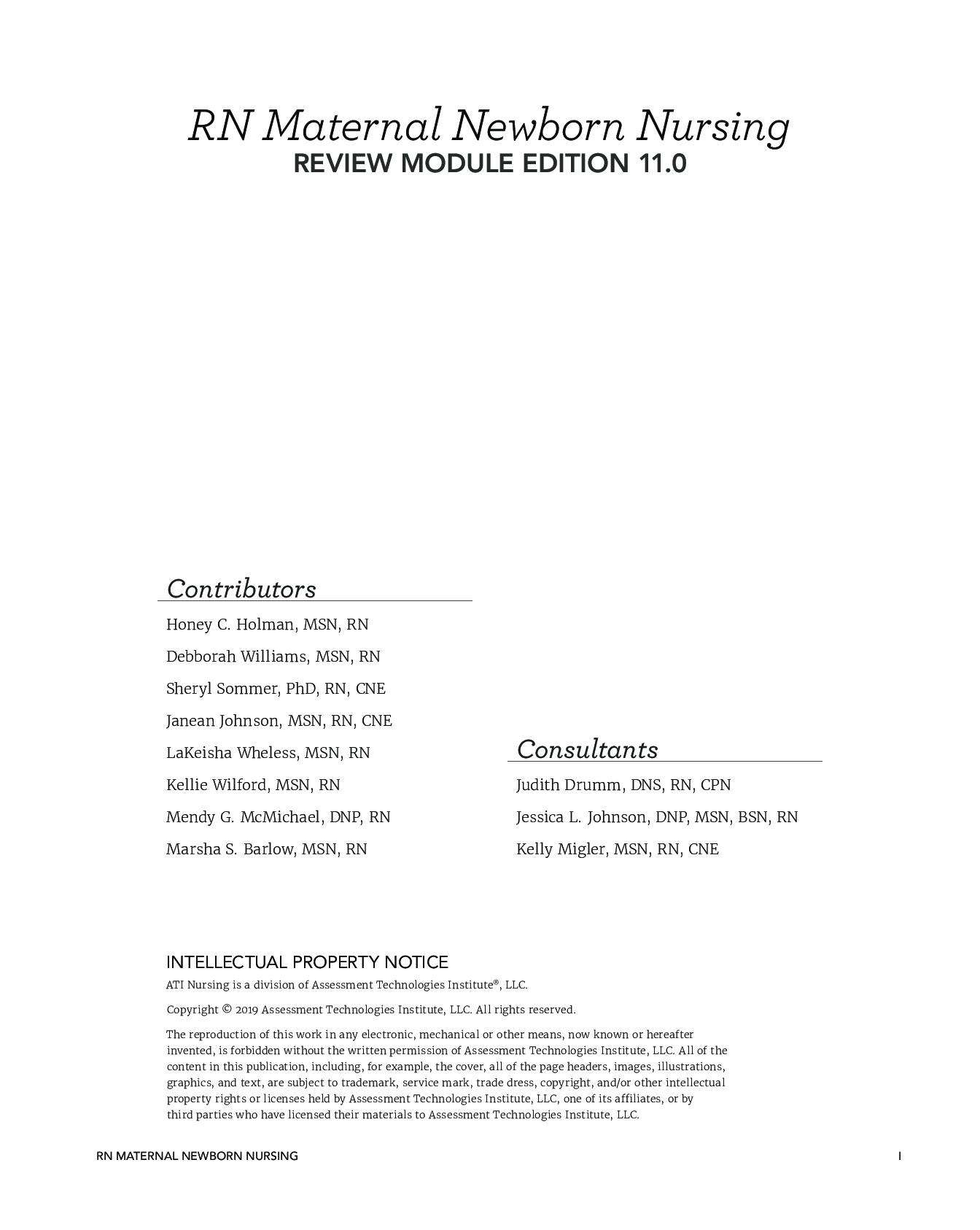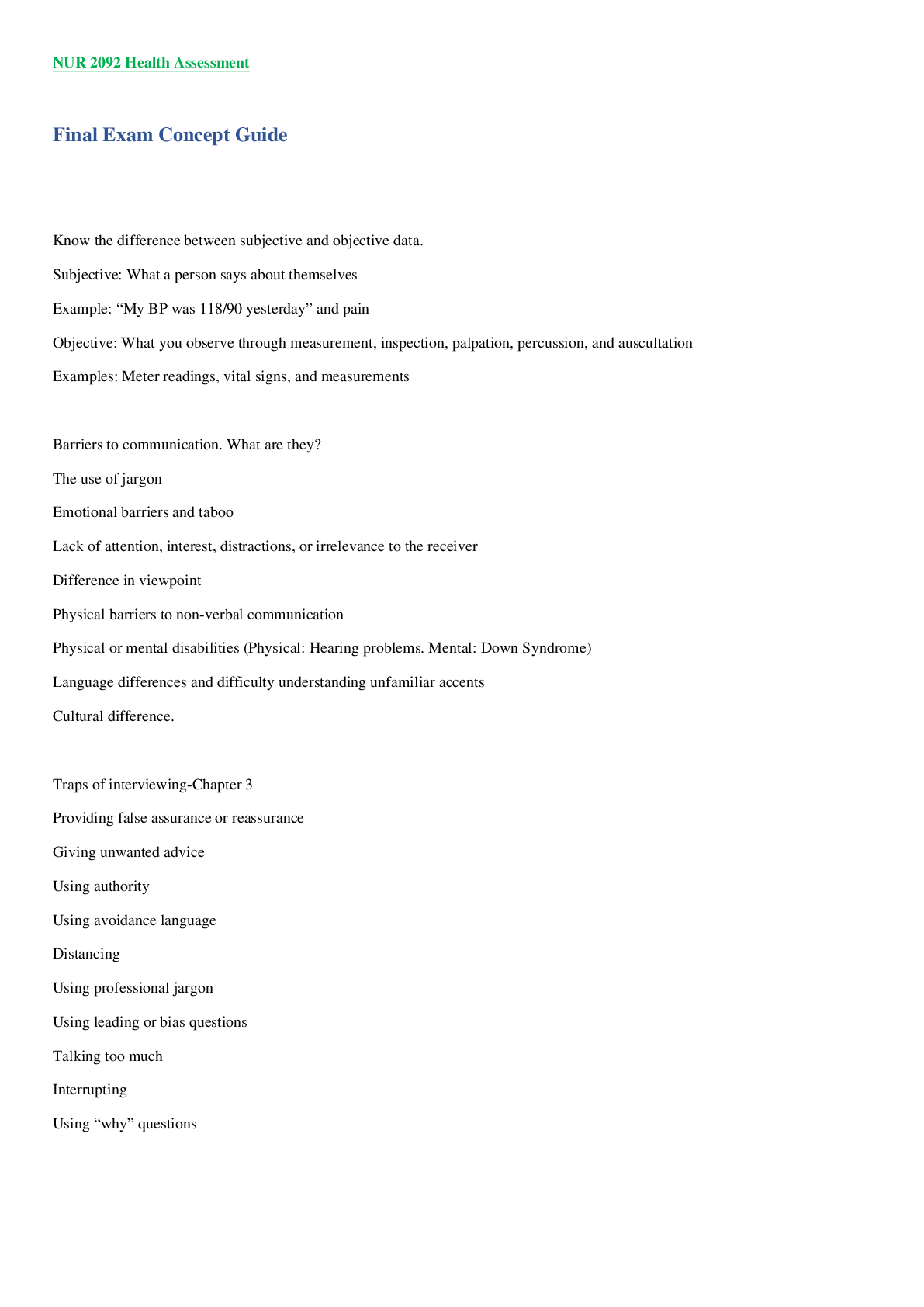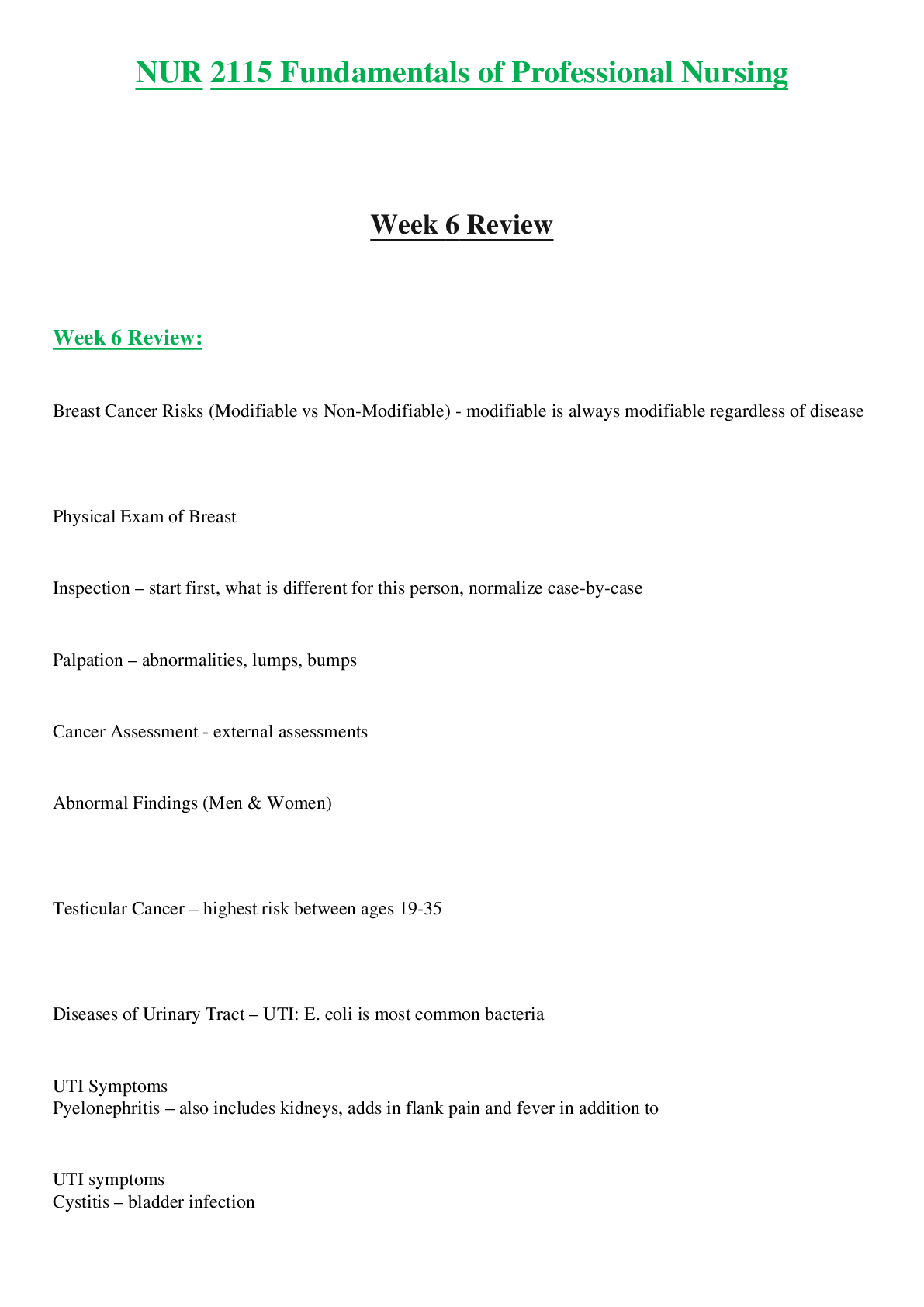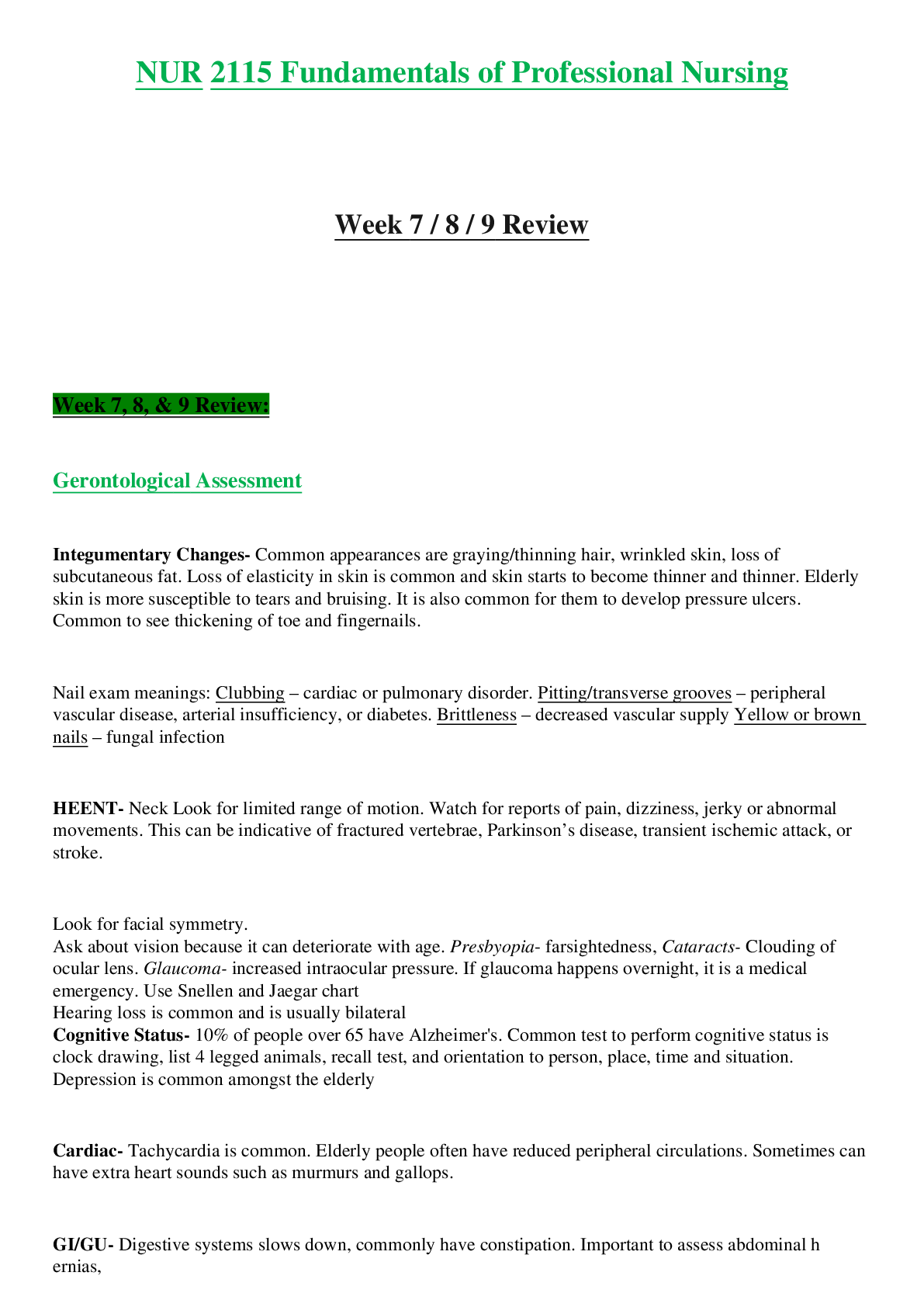HESI EXIT REVIEW| HESI Exit Review Test Bank, Latest 2020/2021 solutions.
Document Content and Description Below
HESI Exit Review 1. Following discharge teaching, a male client with duodenal ulcer tells the nurse the he will drink plenty of dairy products, such as milk, to help coat and protect his ulcer. What i
...
s the best follow-up action by the nurse? 2. A male client with hypertension, who received new antihypertensive prescriptions at his last visit returns to the clinic two weeks later to evaluate his blood pressure (BP). His BP is 158/106 and he admits that he has not been taking the prescribed medication because the drugs make him “feel bad”. In explaining the need for hypertension control, the nurse should stress that an elevated BP places the client at risk for which pathophysiological condition? 3. The nurse observes an unlicensed assistive personnel (UAP) positioning a newly admitted client who has a seizure disorder. The client is supine and the UAP is placing soft pillows along the side rails. What action should the nurse implement? 4. An adolescent with major depressive disorder has been taking duloxetine (Cymbalta) for the past 12 days. Which assessment finding requires immediate follow-up? 5. A 60-year-old female client with a positive family history of ovarian cancer has developed an abdominal mass and is being evaluated for possible ovarian cancer. Her Papanicolau (Pap) smear results are negative. What information should the nurse include in the client’s teaching plan? 6. A client who recently underwear a tracheostomy is being prepared for discharge to home. Which instructions is most important for the nurse to include in the discharge plan? 7. In assessing an adult client with a partial rebreather mask, the nurse notes that the oxygen reservoir bag does not deflate completely during inspiration and the client’s respiratory rate is 14 breaths / minute. What action should the nurse implement? 8. During shift report, the central electrocardiogram (EKG) monitoring system alarms. Which client alarm should the nurse investigate firs? 9. During a home visit, the nurse observed an elderly client with diabetes slip and fall. What action should the nurse take first? 10. At 0600 while admitting a woman for a schedule repeat cesarean section (C-Section), the client tells the nurse that she drank a cup a coffee at 0400 because she wanted to avoid getting a headache. Which action should the nurse take first? 11. After placing a stethoscope as seen in the picture, the nurse auscultates S1 and S2 heart sounds. To determine if an S3 heart sound is present, what action should the nurse take first? 12. A 66-year-old woman is retiring and will no longer have a health insurance through her place of employment. Which agency should the client be referred to by the employee health nurse for health insurance needs? 13. A client who is taking an oral dose of a tetracycline complains of gastrointestinal upset. What snack should the nurse instruct the client to take with the tetracycline? 14. Following a lumbar puncture, a client voices several complaints. What complaint indicated to the nurse that the client is experiencing a complication? 15. An elderly client seems confused and reports the onset of nausea, dysuria, and urgency with incontinence. Which action should the nurse implement? 16. The nurse is assisting the mother of a child with phenylketonuria (PKU) to select foods that are in keeping with the child’s dietary restrictions. Which foods are contraindicated for this child? 17. Before preparing a client for the first surgical case of the day, a part-time scrub nurse asks the circulating nurse if a 3 minute surgical hand scrub is adequate preparation for this client. Which response should the circulating nurse provide? 18. Which breakfast selection indicates that the client understands the nurse’s instructions about the dietary management of osteoporosis? 19. The charge nurse of a critical care unit is informed at the beginning of the shift that less than the optimal number of registered nurses will be working that shift. In planning assignments, which client should receive the most care hours by a registered nurse (RN)? 20. A mother brings her 6-year-old child, who has just stepped on a rusty nail, to the pediatrician’s office. Upon inspection, the nurse notes that the nail went through the shoe and pierced the bottom of the child’s foot. Which action should the nurse implement first? 21. The mother of an adolescent tells the clinic nurse, “My son has athlete’s foot, I have been applying triple antibiotic ointment for two days, but there has been no improvement.” What instruction should the nurse provide? 22. A 26-year-old female client is admitted to the hospital for treatment of a simple goiter, and levothyroxine sodium (Synthroid) is prescribed. Which symptoms indicate to the nurse that the prescribed dosage is too high for this client? The client experiences 23. A client with a history of heart failure presents to the clinic with a nausea, vomiting, yellow vision and palpitations. Which finding is most important for the nurse to assess to the client? 24. The healthcare provider prescribes an IV solution of isoproterenol (Isuprel) 1 mg in 250 ml of D5W at 300 mcg/hour. The nurse should program the infusion pump to deliver how many ml/hour? (Enter numeric value only.) 25. The pathophysiological mechanism are responsible for ascites related to liver failure? (Select all that apply) 26. The nurse is auscultating a client’s heart sounds. Which description should the nurse use to document this sound? (Please listen to the audio first to select the option that applies) 27. The healthcare provider prescribes celtazidime (Fortax) 35 mg every 8 hours IM for an infant. The 500 mg vial is labeled with the instruction to add 5.3 ml diluent to provide a concentration of 100 mg/ml. How many ml should the nurse administered for each dose? (Enter numeric value only. If rounding is required, round to the nearest tenth) 28. The nurse notes that a client has been receiving hydromorphone (Dilaudid) every six hours for four days. What assessment is most important for the nurse to complete? 29. A female client is admitted with end stage pulmonary disease is alert, oriented, and complaining of shortness of breath. The client tells the nurse that she wants “no heroic measures” taken if she stops breathing, and she asks the nurse to document this in her medical record. What action should the nurse implement? 30. A client is receiving a full strength continuous enteral tube feeding at 50 ml/hour and has developed diarrhea. The client has a new prescription to change the feeding to half strength. What intervention should the nurse implement? 31. A female client reports that her hair is becoming coarse and breaking off, that the outer part of her eyebrows have disappeared, and that her eyes are all puffy. Which follow-up question is best for the nurse to ask? 32. After a third hospitalization 6 months ago, a client is admitted to the hospital with ascites and malnutrition. The client is drowsy but responding to verbal stimuli and reports recently spitting up blood. What assessment finding warrants immediate intervention by the nurse? 33. After the nurse witnesses a preoperative client sign the surgical consent form, the nurse signs the form as a witness. What are the legal implications of the nurse’s signature on the client’s surgical consent form? (Select all that apply) 34. Following surgery, a male client with antisocial personality disorder frequently requests that a specific nurse be assigned to his care and is belligerent when another nurse is assigned. What action should the charge nurse implement? 35. A client with cervical cancer is hospitalized for insertion of a sealed internal cervical radiation implant. While providing care, the nurse finds the radiation implant in the bed. What action should the nurse take? 36. The client with which type of wound is most likely to need immediate intervention by the nurse? 37. The nurse is planning care for a client admitted with a diagnosis of pheochromocytoma. Which intervention has the highest priority for inclusion in this client’s plan of care? 38. When caring for a client who has acute respiratory distress syndrome (ARDS), the nurse elevates the head of the bed 30 degrees. What is the reason for this intervention? 39. When assessing a mildly obese 35-year-old female client, the nurse is unable to locate the gallbladder when palpating below the liver margin at the lateral border of the rectus abdominal muscle. What is the most likely explanation for failure to locate the gallbladder by palpation? 40. A woman with an anxiety disorder calls her obstetrician’s office and tells the nurse of increased anxiety since the normal vaginal delivery of her son three weeks ago. Since she is breastfeeding, she stopped taking her antianxiety medications, but thinks she may need to start taking them again because of her increased anxiety. What response is best for the nurse to provide this woman? 41. An older male client with a history of type 1 diabetes has not felt well the past few days and arrives at the clinic with abdominal cramping and vomiting. He is lethargic, moderately, confused, and cannot remember when he took his last dose of insulin or ate last. What action should the nurse implement first? 42. A client who received multiple antihypertensive medications experiences syncope due to a drop in blood pressure to 70/40. What is the rationale for the nurse’s decision to hold the client’s scheduled antihypertensive medication? 43. Which client is at the greatest risk for developing delirium? 44. Which intervention should the nurse include in a long-term plan of care for a client with Chronic Obstructive Pulmonary Disease (COPD)? 45. Which location should the nurse choose as the best for beginning a screening program for hypothyroidism? 46. A female client has been taking a high dose of prednisone, a corticosteroid, for several months. After stopping the medication abruptly, the client reports feeling “very tired”. Which nursing intervention is most important for the nurse to implement? 47. A male client reports the onset of numbness and tingling in his fingers and around his mouth. Which lab is important for the nurse to review before contacting the health care provider? 48. What explanation is best for the nurse to provide a client who asks the purpose of using the log-rolling technique for turning? 49. A client receiving chemotherapy has severe neutropenia. Which snack is best for the nurse to recommend to the client? 50. Which action should the school nurse take first when conducting a screening for scoliosis? 51. An unlicensed assistive personnel (UAP) assigned to obtain client vital signs reports to the charge nurse that a client has a weak pulse with a rate of 44 beat/ minutes. What action should the charge nurse implement? 52. After a sudden loss of consciousness, a female client is taken to the ED and initial assessment indicate that her blood glucose level is critically low. Once her glucose level is stabilized, the client reports that was recently diagnosed with anorexia nervosa and is being treated at an outpatient clinic. Which intervention is more important to include in this client’s discharge plan? 53. A client with a peripherally inserted central catheter (PICC) line has a fever. What client assessment is most important for the nurse to perform? 54. The nurse administers an antibiotic to a client with respiratory tract infection. To evaluate the medication’s effectiveness, which laboratory values should the nurse monitor? Select all that apply 55. A client is admitted to isolation with the diagnosis of active tuberculosis. Which infection control measures should the nurse implement? 56. A school nurse is called to the soccer field because a child has a nose bleed (epistaxis). In what position should the nurse place the child? 57. A young adult who is hit with a baseball bat on the temporal area of the left skull is conscious when admitted to the ED and is transferred to the Neurological Unit to be monitored for signs of closed head injury. Which assessment finding is indicative of a developing epidural hematoma? 58. A female client with breast cancer who completed her first chemotherapy treatment today at an out-patient center is preparing for discharge. Which behavior indicates that the client understands her care needs 59. Which instruction should the nurse provide a pregnant client who is complaining of heartburn? 60. A client is admitted to the intensive care unit with diabetes insipidus due to a pituitary gland tumor. Which potential complication should the nurse monitor closely? 61. A female client reports she has not had a bowel movement for 3 days, but now is defecating frequent small amount of liquid stool. Which action should the nurse implement? 62. After changing to a new brand of laundry detergent, an adult male reports that he has a fine itchy rash. Which assessment finding warrants immediate intervention by the nurse? 63. The nurse should teach the parents of a 6 year-old recently diagnosed with asthma that the symptom of acute episode of asthma are due to which physiological response? 64. A 10 year old who has terminal brain cancer asks the nurse, "What will happen to my body when I die?" How should the nurse respond? 65. The nurse is assessing a 3-month-old infant who had a pylorotomy yesterday. This child should be medicated for pain based on which findings? Select all that apply: 66. The nurse is preparing to administer an oral antibiotic to a client with unilateral weakness, ptosis, mouth drooping and, aspiration pneumonia. What is the priority nursing assessment that should be done before administering this medication? 67. The nurse who is working on a surgical unit receives change of shift report on a group of clients for the upcoming shift. A client with which condition requires the most immediate attention by the nurse? 68. The nurse is caring for a client who had gastric bypass surgery yesterday. Which intervention is most important for the nurse to implement during the first 24 postoperative hours? 69. When preparing to discharge a male client who has been hospitalized for an adrenal crisis, the client expresses concern about having another crisis. He tells the nurse that he wants to stay in the hospital a few more days. Which intervention should the nurse implement? 70. An adult female client tells the nurse that though she is afraid her abusive boyfriend might one day kill her, she keeps hoping that he will change. What action should the nurse take first? 71. In caring for a client with Cushing syndrome, which serum laboratory value is most important for the nurse to monitor? 72. Azithromycin is prescribed for an adolescent female who has lower lobe pneumonia and recurrent chlamydia. What information is most important for the nurse to provide to this client? 73. A client in the emergency center demonstrates rapid speech, flight of ideas, and reports sleeping only three hours during the past 48h. Based on these finding, it is most important for the nurse to review the laboratory value for which medication? 74. A male client who is admitted to the mental health unit for treatment of bipolar disorder has a slightly slurred speech pattern and an unsteady gait. Which assessment finding is most important for the nurse to report to the healthcare provider? 75. A client was admitted to the cardiac observation unit 2 hours ago complaining of chest pain. On admission, the client’s EKG showed bradycardia, ST depression, but no ventricular ectopy. The client suddenly reports a sharp increase in pain, telling the nurse, “I feel like an elephant just stepped on my chest” The EKG now shows Q waves and ST segment elevations in the anterior leads. What intervention should the nurse perform? 76. The nurse is developing a teaching program for the community. What population characteristic is most influential when choosing strategies for implementing a teaching plan? 77. A client is being discharged with a prescription for warfarin (Coumadin). What instruction should the nurse provide this client regarding diet? 78. A client who had a small bowel resection acquired methicillin resistant staphylococcus aureus (MRSA) while hospitalized. He treated and released, but is readmitted today because of diarrhea and dehydration. It is most important for the nurse to implement which intervention. 79. A postoperative female client has a prescription for morphine sulfate 10 mg IV q3 hours for pain. One dose of morphine was administered when the client was admitted to the post anesthesia care unit (PACU) and 3 hours later, the client is again complaining of pain. Her current respiratory rate is 8 breaths/minute. What action should the nurse take? 80. Which intervention is most important for the nurse to include in the plan of care for an older woman with osteoporosis? 81. Based on the information provided in this client’s medical record during labor, which should the nurse implement? (Click on each chart tab for additional information. Please be sure to scroll to the bottom right corner of each tab to view all information contained in the client’s medical record.) 82. An unlicensed assistive personnel UAP leaves the unit without notifying the staff. In what order should the unit manager implement this intervention to address the UAPs behavior? (Place the action in order from first on top to last on bottom.) 83. A client with intestinal obstructions has a nasogastric tube to low intermittent suction and is receiving an IV of lactated ringer’s at 100 ml/H. which finding is most important for the nurse to report to the healthcare provider? 84. Which type of Leukocyte is involved with allergic responses and the destruction of parasitic worms? 85. The healthcare provider prescribes the antibiotic cephradine 500mg PO every 6 hours for a client with a postoperative wound infection. Which foods should the nurse encourage this client to eat? 86. Several months after a foot injury, and adult woman is diagnosed with neuropathic pain. The client describes the pain as severe and burning and is unable to put weight on her foot. She asks the nurse when the pain will “finally go away.” How should the nurse respond? 87. One day following an open reduction and internal fixation of a compound fracture of the leg, a male client complains of “a tingly sensation” in his left foot. The nurse determines the client’s left pedal pulses are diminished. Based on these finding, what is the client’s greatest risk? 88. The nurse is completing a head to be assessment for a client admitted for observation after falling out of a tree. Which finding warrants immediate intervention by the nurse? 89. A client with multiple sclerosis (MS) has decreased motor function after taking a hot bath (Uhthoff’s sign). Which pathophysiological mechanism supports this response? 90. While assessing a radial artery catheter, the client complains of numbness and pain distal to the insertion site. What interventions should the nurse implement? 91. A client is admitted with an epidural hematoma that resulted from a skateboarding accident. To differentiate the vascular source of the intracranial bleeding, which finding should the nurse monitor? 92. The nurse finds a client at 33 weeks gestation in cardiac arrest. What adaptation to cardiopulmonary resuscitation (CPR) should the nurse implement? 93. When preparing a client for discharge from the hospital following a cystectomy and a urinary diversion to treat bladder cancer, which instruction is most important for the nurse to include in the client’s discharge teaching plan? 94. For the past 24 hours, an antidiarrheal agent, diphenoxylate, has been administered to a bedridden, older client with infectious gastroenteritis. Which finding requires the nurse to take further action? 95. After repositioning an immobile client, the nurse observes an area of hyperemia. To assess for blanching, what action should the nurse take? 96. The nurse enters a client’s room and observes the client’s wrist restraint secured as seen in the picture. What action should the nurse take? 97. A female client with acute respiratory distress syndrome (ARDS) is chemically paralyzed and sedated while she is on as assist-control ventilator using 50% FIO2. Which assessment finding warrants immediate intervention by the nurse? 98. The development of atherosclerosis is a process of sequential events. Arrange the pathophysiological events in orders of occurrence. (Place the first event on top and the last on the bottom) 99. Following a motor vehicle collision, an adult female with a ruptured spleen and a blood pressure of 70/44, had an emergency splenectomy. Twelve hours after the surgery, her urine output is 25 ml/hour for the last two hours. What pathophysiological reason supports the nurse’s decision to report this finding to the healthcare provider? 100. A nurse-manager is preparing the curricula for a class for charge nurses. A staffing formula based on what data ensures quality client care and is most cost-effective? 101. When performing postural drainage on a client with Chronic Obstructive Pulmonary Disease (COPD), which approach should the nurse use? 102. A client presents in the emergency room with right-sided facial asymmetry. The nurse asks the client to perform a series of movements that require use of the facial muscles. What symptoms suggest that the client has most likely experience a Bell’s palsy rather than a stroke? 103. The nurse is teaching a client how to perform colostomy irrigations. When observing the client’s return demonstration, which action indicated that the client understood the teaching? 104. The nurse should teach the client to observe which precaution while taking dronedarone? 105. A client who sustained a head injury following an automobile collision is admitted to the hospital. The nurse include the client’s risk for developing increased intracranial pressure (ICP) in the plan of care. Which signs indicate to the nurse that ICP has increased? 106. The nurse is caring for a client receiving continuous IV fluids through a single lumen central venous catheter (CVC). Based on the CVC care bundle, which action should be completed daily to reduce the risk for infection? 107. During an annual physical examination, an older woman’s fasting blood sugar (FBS) is determined to be 140 mg/dl or 7.8 mmol/L (SI). Which additional finding obtained during a follow-up visit 2 weeks later is most indicative that the client has diabetes mellitus (DM)? 108. A new mother tells the nurse that she is unsure if she will be able to transition into parenthood. What action should the nurse take? 109. A client who was admitted yesterday with severe dehydration is complaining of pain a 24 gauge IV with normal saline is infusing at a rate of 150 ml/hour. Which intervention should the nurse implement first? 110. An elderly female is admitted because of a change in her level of sensorium. During the evening shift, the client attempts to get out bed and falls, breaking her left hip. Buck’s skin traction is applied to the left leg while waiting for surgery. Which intervention is most important for the nurse to include in this client’s plan care? 111. An Unna boot is applied to a client with a venous stasis ulcer. One week later, when the Unna boot is removed during a follow-up appointment, the nurse observes that the ulcer site contains bright red tissue. What action should the nurse take in response to this finding? 112. At the end of a preoperative teaching session on pain management techniques, a client starts to cry and states, “I just know I can’t handle all the pain.” What is the priority nursing diagnosis for this client? 113. The nurse note a visible prolapse of the umbilical cord after a client experiences spontaneous rupture of the membranes during labor. What intervention should the nurse implement immediately? 114. A client who had a right hip replacement 3 day ago is pale has diminished breath sound over the left lower lung fields, a temperature of 100.2 F, and an oxygen saturation rate of 90%. The client is scheduled to be transferred to a skilled nursing facility (SNF) tomorrow for rehabilitative critical pathway. Based on the client’s symptoms, what recommendation should the nurse give the healthcare provider? 115. A client who is newly diagnosed with type 2 diabetes mellitus (DM) receives a prescription for metformin (Glucophage) 500 mg PO twice daily. What information should the nurse include in this client’s teaching plan? (Select all that apply.) 116. The nurse is developing an educational program for older clients who are being discharged with new antihypertensive medications. The nurse should ensure that the educational materials include which characteristics? Select all that apply 117. During the admission assessment, the nurse auscultates heart sounds for a client with no history of cardiovascular disease. Where should the nurse listen when assessing the client’s point of maximal impulse (PMI) (Click the chosen location. To change, click on a new location) 118. An older male adult resident of long-term care facility is hospitalized for a cardiac catheterization that occurred yesterday. Since the procedure was conducted, the client has become increasingly disoriented. The night shift nurse reports that he attempted to remove the sandbag from his femoral artery multiple times during the night. What actions should the nurse take? (Select all that apply.) 119. An older male comes to the clinic with a family member. When the nurse attempts to take the client’s health history, he does not respond to questions in a clear manner. What action should the nurse implement first? 120. The nurse caring for a client with acute renal fluid (ARF) has noted that the client has voided 800 ml of urine in 4 hours. Based on this assessment, what should the nurse anticipate that client will need? 121. Which intervention should the nurse include in the plan of care for a child with tetanus? 122. Suicide precautions are initiated for a child admitted to the mental health unit following an intentional narcotic overdose. After a visitor leaves, the nurse finds a package of cigarettes in the client’s room. Which intervention is most important for the nurse to implement? 123. A family member of a frail elderly adult asks the nurse about eligibility requirements for hospice care. What information should the nurse provide? (Select all that apply.) 124. A client with atrial fibrillation receives a new prescription for dabigatran. What instruction should the nurse include in this client’s teaching plan? 125. A nurse with 10 years experience working in the emergency room is reassigned to the perinatal unit to work an 8 hour shift. Which client is best to assign to this nurse? 126. An infant who is admitted for surgical repair of a ventricular septal defect (VSD) is irritable and diaphoretic with jugular vein distention. Which prescription should the nurse administer first? 127. The nursing staff on a medical unit includes a registered nurse (RN), practical nurse (PN), and an unlicensed assistive personnel (UAP). Which task should the charge nurse assign to the RN? 128. While teaching a young male adult to use an inhaler for his newly diagnosed asthma, the client stares into the distance and appears to be concentrating on something other than the lesson the nurse is presenting. What action should the nurse take? 129. After several hours of non-productive coughing, a client presents to the emergency room complaining of chest tightness and shortness of breath. History includes end stage chronic obstructive pulmonary disease (COPD) and diabetes mellitus. While completing the pulmonary assessment, the nurse hears wheezing and poor air movement bilaterally. Which actions should the nurse implement? (Select all that apply.) 130. The nurse caring for a 3-month-old boy one day after a pylorotomy notices that the infant is restless, is exhibiting facial grimaces, and is drawing his knees to his chest. What action should the nurse take? 131. A 4-year-old with acute lymphocytic leukemia (ALL) is receiving a chemotherapy (CT) protocol that includes methotrexate (Mexate, Trexal, MIX), an antimetabolite. Which information should the nurse provide the parents about caring for their child? 132. Two days after admission a male client remembers that he is allergic to eggs, and informs the nurse of the allergy. Which actions should the nurse implement? (Select all that apply) 133. The rapid response team’s detects return of spontaneous circulation (ROSC) after 2 min of continuous chest compressions. The client has a weak, fast pulse and no respiratory effort, so the healthcare provider performs a successful oral, intubation. What action should the nurse implement? 134. After administering an antipyretic medication. Which intervention should the nurse implement? 135. A client with hyperthyroidism is being treated with radioactive iodine (I-131). Which explanation should be included in preparing this client for this treatment? 136. After a colon resection for colon cancer, a male client is moaning while being transferred to the Postanesthesia Care Unit (PACU). Which intervention should the nurse implement first? 137. The nurse is caring for a group of clients with the help of a licensed practical nurse (LPN) and an experienced unlicensed assistive personnel (UAP). Which procedures can the nurse delegate to the UAP? (Select all that apply) 138. A male client with cirrhosis has ascites and reports feeling short of breath. The client is in semi Fowler position with his arms at his side. What action should the nurse implement? 139. A client with a history of chronic pain requests a nonopioid analgesic. The client is alert but has difficulty describing the exact nature and location of the pain to the nurse. Which action should the nurse implement next? 140. A client with a chronic health problem has difficulty ambulating short distance due to generalized weakness, but is able to bear weight on both legs. To assist with ambulation and provide the greatest stability, what assistive device is best for this client? 141. The nurse uses the parkland formula (4ml x kg x total body surface area = 24 hours fluid replacement) to calculate the 24-hours IV fluid replacement for a client with 40% burns who weighs 76kg. How many ml should the client receive? (Enter numeric value only.) 142. A client with leukemia undergoes a bone marrow biopsy. The client’s laboratory values indicate the client has thrombocytopenia. Based on this data, which nursing assessment is most important following the procedure? 143. An 18-year-old female client is seen at the health department for treatment of condylomata acuminate (perineal warts) caused by the human papillomavirus (HPV). Which intervention should the nurse implement? 144. A client admitted to the psychiatric unit diagnosed with major depression wants to sleep during the day, refuses to take a bath, and refuses to eat. Which nursing intervention should the nurse implement first? 145. A client with history of bilateral adrenalectomy is admitted with a week, irregular pulse, and hypotension. Which assessment finding warrants immediate intervention by the nurse? 146. The mother of a 7-month-old brings the infant to the clinic because the skin in the diaper area is excoriated and red, but there are no blisters or bleeding. The mother reports no evidence of watery stools. Which nursing intervention should the nurse implement? 147. A resident of a long-term care facility, who has moderate dementia, is having difficulty eating in the dining room. The client becomes frustrated when dropping utensils on the floor and then refuses to eat. What action should the nurse implement? 148. A client is receiving mesalamine 800 mg PO TID. Which assessment is most important for the nurse to perform to assess the effectiveness of the medication? 149. While in the medical records department, the nurse observes several old medical records with names visible in waste container. What action should the nurse implement? 150. A 16-year-old adolescent with meningococcal meningitis is receiving a continuous IV infusion of penicillin G, which is prescribed as 20 million units in a total volume of 2 liters of normal saline every 24 hr. The pharmacy delivers 10 million units/ liters of normal saline. How many ml/hr should the nurse program the infusion pump? (Enter numeric value only. If rounding is required, round to the nearest whole number.) 151. While visiting a female client who has heart failure (HF) and osteoarthritis, the home health nurse determines that the client is having more difficulty getting in and out of the bed than she did previously. Which action should the nurse implement first? 152. A client has an intravenous fluid infusing in the right forearm. To determine the client’s distal pulse rate most accurately, which action should the nurse implement? 153. A child is admitted to the pediatric unit diagnosed with sickle cell crisis. When the nurse walks into the room, the unlicensed assistive personnel (UAP) is encouraging the child to stay in bed in the supine position. Which action should the nurse implement? 154. A preschool-aged boy is admitted to the pediatric unit following successful resuscitation from a near-drowning incident. While providing care to child, the nurse begins talking with his preadolescent brother who rescued the child from the swimming pool and initiated resuscitation. The nurse notices the older boy becomes withdrawn when asked about what happened. What action should the nurse take? 155. After six days on a mechanical ventilator, a male client is extubated and place on 40% oxygen via face mask. He is awake and cooperative, but complaining of a severe sore throat. While sipping water to swallow a medication, the client begins coughing, as if strangled. What intervention is most important for the nurse to implement? 156. The nurse is interacting with a female client who is diagnosed with postpartum depression. Which finding should the nurse document as an objective signs of depression? (Select all that apply) 157. A client in the postanesthesia care unit (PACU) has an eight (8) on the Aldrete postanesthesia scoring system. What intervention should nurse implement? 158. In caring for the body of a client who just died, which tasks can be delegate to the unlicensed assistive personnel (UAP)? (Select all that apply.) 159. An adult male reports the last time he received penicillin he developed a severe maculopapular rash all over his chest. What information should the nurse provide the client about future antibiotic prescriptions? 160. A client with a prescription for “do not resuscitate” (DNR) begins to manifest signs of impending death. After notifying the family of the client’s status, what priority action should the nurse implement? 161. A client with cirrhosis of the liver is admitted with complications related to end stage liver disease. Which intervention should the nurse implement? (Select all that apply.) 162. During discharge teaching, the nurse discusses the parameters for weight monitoring with a client who was recently diagnosed with heart failure (HF). Which information is most important for the client to acknowledge? 163. Which problem, noted in the client’s history, is important for the nurse to be aware of prior to administration of a newly prescribed selective serotonin reuptake inhibitor (SSRI)? 164. When implementing a disaster intervention plan, which intervention should the nurse implement first? 165. The nurse is evaluating a client’s symptoms, and formulates the nursing diagnosis, “high risk for injury due to possible urinary tract infection.” Which symptoms indicate the need for this diagnosis? 166. A client is admitted with metastatic carcinoma of the liver, ascites, and bilateral 4 pitting edema of both lower extremities. When the client complains that the antiembolic stocking are too constricting, which intervention should the nurse implement? 167. A client with muscular dystrophy is concerned about becoming totally dependent and is reluctant to call the nurse to assist with activities of daily living (ADLs). To achieve maximum mobility and independence, which intervention is most important for the nurse to include in the client’s plan of care? 168. The nurse is teaching a postmenopausal client about osteoporosis prevention. The client reports that she smokes 2 packs of cigarettes a day and takes 750 mg calcium supplements daily. What information should the nurse include when teaching this client about osteoporosis prevention? 169. When evaluating a client’s rectal bleeding, which findings should the nurse document? 170. The nurse is auscultating a client’s lung sounds. Which description should the nurse use to document this sound? 171. An adult male is admitted to the emergency department after falling from a ladder. While waiting to have a computed tomography (CT) scan, he requests something for a severe headache. When the nurse offers him a prescribed does of acetaminophen, he asks for something stronger. Which intervention should the nurse implement? 172. The nurse is managing the care of a client with Cushing’s syndrome. Which interventions should the nurse delegate to the unlicensed assistive personnel (UAP)? (Select all that apply) 173. Ten years after a female client was diagnosed with multiple sclerosis (MS), she is admitted to a community palliative care unit. Which intervention is most important for the nurse to include in the client’s plan of care? 174. An increased number of elderly persons are electing to undergo a new surgical procedure which cures glaucoma. What effect is the nurse likely to note as a result of this increases in glaucoma surgeries? 175. The nurse is caring for a client who is entering the second stage of labor. Which action should the nurse implement first? 176. To evaluate the effectiveness of male client’s new prescription for ezetimibe, which action should the clinic nurse implement? 177. Diagnostic studies indicate that the elderly client has decreased bone density. In providing client teaching, which area of instruction is most important for the nurse to include? 178. A young adult client is admitted to the emergency room following a motor vehicle collision. The client’s head hit the dashboard. Admission assessment include: Blood pressure 85/45 mm Hg, temperature 98.6 F, pulse 124 beat/minute and respirations 22 breath/minute. Based on these data, the nurse formulates the first portion of nursing diagnosis as ” Risk of injury” What term best expresses the “related to” portion of nursing diagnosis? 179. An older male client with history of diabetes mellitus, chronic gout, and osteoarthritis comes to the clinic with a bag of medication bottles. Which intervention should the nurse implement first? 180. A male client who was diagnosed with viral hepatitis A 4 weeks ago returns to the clinic complaining of weakness and fatigue. Which finding is most important for the nurse to report to the healthcare provider? 181. In assessing a client twelve hours following transurethral resection of the prostate (TURP), the nurse observes that the urinary drainage tubing contains a large amount of clear pale pink urine and the continuous bladder irrigation is infusing slowly. What action should the nurse implement? 182. The healthcare provider prescribes the antibiotic Cefdinir (cephalosporin) 300mg PO every 12 h for a client with postoperative wound infections. Which feeds should the nurse encourage this client to eat? 183. The charge nurse is making assignment on a psychiatric unit for a practical nurse (PN) and newly license register nurse (RN). Which client should be assigned to the RN? 184. A client at 30 week gestation is admitted due to preterm labor. A prescription of terbutaline sulfate 8.35 mg is gives subcutaneously. Based on which finding should the nurse withhold the next dose of this drug? 185. In assessing an older female client with complication associated with chronic obstructive pulmonary disease (COPD), the nurse notices a change in the client’s appearance. Her face appears tense and she begs the nurse not to leave her alone. Her pulse rate is 100, and respirations are 26 per min. What is the primary nursing diagnosis? 186. A client with a cervical spinal cord injury (SCI) has Crutchfield tongs and skeletal traction applied as a method of closed reduction. Which intervention is most important for the nurse to include in the client’s a plan of care? 187. A client arrives on the surgical floor after major abdominal surgery. What intervention should the nurse perform first? 188. A client is admitted to the emergency department with a respiratory rate of 34 breaths per minute and high pitched wheezing on inspiration and expiration, the medical diagnosis is severe exacerbation of asthma. Which assessment finding, obtained 10 min after the admission assessment, should the nurse report immediately to the emergency department healthcare provider? 189. The nurse is planning a class for a group of clients with diabetes mellitus about blood glucose monitoring. In teaching the class as a whole, the nurse should emphasize the need to check glucose levels in which situation? 190. A 350-bed acute care hospital declares an internal disaster because the emergency generators malfunctioned during a city-wide power failure. The UAPs working on a general medical unit ask the charge nurse what they should do first. What instruction should the charge nurse provide to these UAPs? 191. The nurse is auscultating is auscultating a client’s heart sounds. Which description should the nurse use to document this sound? (Please listen to the audio file to select the option that applies.) 192. The healthcare provider changes a client’s medication prescription from IV to PO administration and double the dose. The nurse notes in the drug guide that the prescribed medication, when given orally, has a high first-pass effect and reduce bioavailability. What action should the nurse implement? 193. A client refuses to ambulate, reporting abdominal discomfort and bloating caused by “too much gas buildup” the client’s abdomen is distended. Which prescribed PRN medication should the nurse administer? 194. The public nurse health received funding to initiate primary prevention program in the community. Which program the best fits the nurse’s proposal? 195. When assessing and adult male who presents as the community health clinic with a history of hypertension, the nurse note that he has 2 pitting edema in both ankles. He also has a history of gastroesophageal reflex disease (GERD) and depression. Which intervention is the most important for the nurse to implement? 196. An older client is admitted to the intensive care unit with severe abdominal pain, abdominal distention, and absent bowel sound. The client has a history of smoking 2 packs of cigarettes daily for 50 years and is currently restless and confused. Vital signs are: temperature 96`F, heart rate 122 beats/minute, respiratory rate 36 breaths/minute, mean arterial pressure(MAP) 64 mmHg and central venous pressure (CVP) 7 mmHg. Serum laboratory findings include: hemoglobin 6.5 grams/dl, platelets 6o, 000, and white blood cell count (WBC) 3,000/mm3. Based on these findings this client is at greatest risk for which pathophysiological condition? 197. A man expresses concern to the nurse about the care his mother is receiving while hospitalized. He believes that her care is not based on any ethical standards and ask what type of care he should expect from a public hospital. What action should the nurse take? 198. A client experiencing withdrawal from the benzodiazepines alprazolam (Xanax) is demonstrating severe agitation and tremors. What is the best initial nursing action? 199. The nurse is caring for a client who is taking a macrolide to treat a bacterial infection. Which finding should the nurse report to the healthcare provider before administering the next dose? 200. A client with Alzheimer’s disease (AD) is receiving trazodone (Desyrel), a recently prescribed atypical antidepressant. The caregiver tells the home health nurse that the client’s mood and sleep patterns are improved, but there is no change in cognitive ability. How should the nurse respond to this information? 201. A client with diabetic peripheral neuropathy has been taking pregabalin (Lyrica) for 4 days. Which finding indicates to the nurse that the medication is effective? 202. A group of nurse-managers is asked to engage in a needs assessment for a piece of equipment that will be expensed to the organization’s budget. Which question is most important to consider when analyzing the cost-benefit for this piece of equipment? 203. While receiving a male postoperative client’s staples de nurse observe that the client’s eyes are closed and his face and hands are clenched. The client states, “I just hate having staples removed”. After acknowledgement the client’s anxiety, what action should the nurse implement? 204. A male client is admitted for the removal of an internal fixation that was inserted for the fracture ankle. During the admission history, he tells the nurse he recently received vancomycin (vancomycin) for a methicillin-resistant Staphylococcus aureus (MRSA) wound infection. Which action should the nurse take? (Select all that apply.) 205. A vacuum-assistive closure (VAC) device is being use to provide wound care for a client who has stage III pressure ulcer on a below-the- knee (BKA) residual limb. Which intervention should the nurse implement to ensure maximum effectiveness of the device? 206. The nurse is developing the plan of care for a client with pneumonia and includes the nursing diagnosis of “Ineffective airway clearance related to thick pulmonary secretions.” Which intervention is most important for the nurse to include in the client’s plan of care? 207. The nurse plans to collect a 24- hour urine specimen for a creatinine clearance test. Which instruction should the nurse provide to the adult male client? 208. The nurse is preparing to administer a histamine 2-receptor antagonist to a client with peptic ulcer disease. What is the primary purpose of this drug classification? 209. The healthcare provider prescribes acarbose (Precose), an alpha-glucosidase inhibitor, for a client with Type 2 diabetes mellitus. Which information provides the best indicator of the drug’s effectiveness? 210. The nurse assesses a client with new onset diarrhea. It is most important for the nurse to question the client about recent use of which type of medication? 211. A neonate with a congenital heart defect (CHD) is demonstrating symptoms of heart failure (HF). Which interventions should the nurse include in the infant’s plan of care? 212. The nurse is caring for a 4-year-old male child who becomes unresponsive as his heart rate decreases to 40 beats/minute. His blood pressure is 88/70 mmHg, and his oxygen saturation is 70% while receiving 100% oxygen by non-rebreather face mask. In what sequence, from first to last, should the nurse implement these actions? (Place the first action on top and last action on the bottom.) 213. An elderly male client is admitted to the mental health unit with a sudden onset of global disorientation and is continuously conversing with his mother, who died 50 years ago. The nurse reviews the multiple prescriptions he is currently taking and assesses his urine specimen, which is cloudy, dark yellow, and has foul odor. These findings suggest that his client is experiencing which condition? 214. Following an esophagogastroduodenoscopy (EGD) a male client is drowsy and difficult to arouse, and his respiration are slow and shallow. Which action should the nurse implement? Select all that apply. 215. The nurse is planning preoperative teaching plan of a 12-years old child who is scheduled for surgery. To help reduce the child anxiety, which action is the best for the nurse to implement? 216. Which intervention should the nurse implement during the administration of vesicant chemotherapeutic agent via an IV site in the client’s arm? 217. When development a teaching plan for a client newly diagnosed type 1 diabetes, the nurse should explain that an increase thirst is an early sing of diabetes ketoacidosis (DKA), which action should the nurse instruct the client to implement if this sign of DKA occur? 218. The nurse is teaching a group of clients with rheumatoid arthritis about the need to modify daily activities. Which goal should the nurse emphasize? 219. An adult client experiences a gasoline tank fire when riding a motorcycle and is admitted to the emergency department (ED) with full thickness burns to all surfaces of both lower extremities. What percentage of body surface area should the nurse document in the electronic medical record (EMR)? 220. A client with hyperthyroidism is receiving propranolol (Inderal). Which finding indicates that the medication is having the desired effect? 221. An older male client with type 2 diabetes mellitus reports that has experiences legs pain when walking short distances, and that the pain is relieved by rest. Which client behavior indicates an understanding of healthcare teaching to promote more effective arterial circulation? 222. A community health nurse is concerned about the spread of communicable diseases among migrant farm workers in a rural community. What action should the nurse take to promote the success of a healthcare program designed to address this problem? 223. The nurse performs a prescribed neurological check at the beginning of the shift on a client who was admitted to the hospital with a subarachnoid brain attack (stroke). The client’s Glasgow Coma Scale (GCS) score is 9. What information is most important for the nurse to determine? 224. The charge nurse in a critical care unit is reviewing clients’ conditions to determine who is stable enough to be transferred. Which client status report indicates readiness for transfer from the critical care unit to a medical unit? 225. Based on principles of asepsis, the nurse should consider which circumstance to be sterile? 226. An unlicensed assistive personnel (UAP) reports that a client’s right hand and fingers spasms when taking the blood pressure using the same arm. After confirming the presence of spams what action should the nurse take? 227. A 56-years-old man shares with the nurse that he is having difficulty making decision about terminating life support for his wife. What is the best initial action by the nurse? 228. A client is being discharged home after being treated for heart failure (HF). What instruction should the nurse include in this client’s discharge teaching plan? 229. A woman just learned that she was infected with Heliobacter pylori. Based on this finding, which health promotion practice should the nurse suggest? 230. A client who recently underwear a tracheostomy is being prepared for discharge to home. Which instructions is most important for the nurse to include in the discharge plan? 231. A child with heart failure is receiving the diuretic furosemide (Lasix) and has serum potassium level 3.0 mEq/L. Which assessment is most important for the nurse to obtain? 232. The nurse note a depressed female client has been more withdrawn and non-communicative during the past two weeks. Which intervention is most important to include in the updated plan of care for this client? 233. A client with rheumatoid arthritis (RA) starts a new prescription of etanercept (Enbrel) subcutaneously once weekly. The nurse should emphasize the importance of reporting problem to the healthcare provider? 234. The nurse is assessing an older adult with type 2 diabetes mellitus. Which assessment finding indicates that the client understands long- term control of diabetes? 235. An older male client is admitted with the medical diagnosis of possible cerebral vascular accident (CVA). He has facial paralysis and cannot move his left side. When entering the room, the nurse finds the client’s wife tearful and trying unsuccessfully to give him a drink of water. What action should the nurse take? 236. A 13 years-old client with non-union of a comminuted fracture of the tibia is admitted with osteomyelitis. The healthcare provider collects home aspirate specimens for culture and sensitivity and applies a cast to the adolescent’s lower leg. What action should the nurse implement next? 237. The nurse is preparing a community education program on osteoporosis. Which instruction is helpful in preventing bone loss and promoting bone formation? 238. A client with a history of chronic pain requests a nonopioid analgesic. The client is alert but has difficulty describing the exact nature and location of the pain to the nurse. What action should the nurse implement next? 239. A male client receives a thrombolytic medication following a myocardial infarction. When the client has a bowel movement, what action should the nurse implement? 240. The mother of a child with cerebral palsy (CP) ask the nurse if her child’s impaired movements will worsen as the child grows. Which response provides the best explanation? 241. During shift report, the central electrocardiogram (EKG) monitoring system alarms. Which client alarm should the nurse investigate first? 242. In early septic shock states, what is the primary cause of hypotension? 243. A client diagnosed with calcium kidney stones has a history of gout. A new prescription for aluminum hydroxide (Amphogel) is scheduled to begin at 0730. Which client medication should the nurse bring to the healthcare provider’s attention? 244. A male client’s laboratory results include a platelet count of 105,000/ mm3 Based on this finding the nurse should include which action in the client’s plan of care? 245. A client is admitted to the hospital after experiencing a brain attack, commonly referred to as a stroke or cerebral vascular accident (CVA). The nurse should request a referral for speech therapy if the client exhibits which finding? 246. At 1615, prior to ambulating a postoperative client for the first time, the nurse reviews the client’s medical record. Based on date contained in the record, what action should the nurse take before assisting the client with ambulation: 247. Which assessment finding for a client who is experiencing pontine myelinolysis should the nurse report to the healthcare provider? 248. A client is scheduled to receive an IW dose of ondansetron (Zofran) eight hours after receiving chemotherapy. The client has saline lock and is sleeping quietly without any restlessness. The nurse caring for the client is not certified in chemotherapy administration. What action should the nurse take? 249. When providing diet teaching for a client with cholecystitis, which types of food choices the nurse recommend to the client? 250. A client with a history of cirrhosis and alcoholism is admitted with severe dyspnea and ascites. Which assessment finding warrants immediate intervention by the nurse? 251. When entering a client’s room, the nurse discovers that the client is unresponsive and pulseless. The nurse initiate CPR and Calls for assistance. Which action should the nurse take next? 252. A client with a history of dementia has become increasingly confused at night and is picking at an abdominal surgical dressing and the tape securing the intravenous (IV) line. The abdominal dressing is no longer occlusive, and the IV insertion site is pink. What intervention should the nurse implement? 253. An adult male client is admitted to the emergency room following an automobile collision in which he sustained a head injury. What assessment data would provide the earliest that the client is experiencing increased intracranial pressure (ICP)? 254. In preparing a diabetes education program, which goal should the nurse identify as the primary emphasis for a class on diabetes self-management? 255. To reduce staff nurse role ambiguity, which strategy should the nurse manager implemented? 256. The nurse is assisting a new mother with infant feeding. Which information should the nurse provide that is most likely to result in a decrease milk supply for the mother who is breastfeeding? 257. Which assessment is more important for the nurse to include in the daily plan of care for a client with a burned extremity? 258. An elderly client with degenerative joint disease asks if she should use the rubber jar openers that are available. The nurse’s response should be based on which information about assistive devices? 259. When assessing a 6-month old infant, the nurse determines that the anterior fontanel is bulging. In which situation would this finding be most significant? 260. A client with angina pectoris is being discharge from the hospital. What instruction should the nurse plan to include in this discharge teaching? 261. What is the priority nursing action when initiating morphine therapy via an intravenous patient-controlled analgesia (PCA) pump? 262. While undergoing hemodialysis, a male client suddenly complains of dizziness. He is alert and oriented, but his skin is cool and clammy. His vital signs are: heart rate 128 beats/minute, respirations 18 breaths/minute, and blood pressure 90/60. Which intervention should the nurse implement first? 263. The nurse receives a newborn within the first minutes after a vaginal delivery and intervenes to establish adequate respirations. What priority issue should the nurse address to ensure the newborn’s survival? 264. The fire alarm goes off while the charge nurse is receiving the shift report. What action should the charge nurse implement first? 265. A 60-year-old female client asks the nurse about hormones replacement therapy (HRT) as a means preventing osteoporosis. Which factor in the client’s history is a possible contraindication for the use of HRT? 266. A male client, who is 24 hours postoperative for an exploratory laparotomy, complains that he is “starving” because he has had no “real food” since before the surgery. Prior to advancing his diet, which intervention should the nurse implement? 267. The nurse working in the psychiatric clinic has phone messages from several clients. Which call should the nurse return first? 268. During change of shift, the nurse reports that a male client who had abdominal surgery yesterday increasingly confused and disoriented during the night. He wandered into other clients rooms, saying that there are men in his room trying to hurt him. Because of continuing disorientation and the client’s multiple attempts to get of bed, soft restrains were applied at 0400. In what order should the nurse who is receiving report implement these interventions? (Arrange from first action on top to last on the bottom). 269. A mother brings her 3-year-old son to the emergency room and tells the nurse the he has had an upper respiratory infection for the past two days. Assessment of the child reveals a rectal temperature of 102 F. he is drooling and becoming increasingly more restless. What action should the nurse take first? 270. After receiving the first dose of penicillin, the client begins wheezing and has trouble breathing. The nurse notifies the healthcare provider immediately and received several prescriptions. Which medication prescription should the nurse administer first? 271. Two clients ring their call bells simultaneously requesting pain medication. What action should the nurse implement first? 272. A client receives a new prescription for simvastatin (Zocor) 5 mg PO daily at bedtime. What action should the nurse take? 273. Which client should the nurse assess frequently because of the risk for overflow incontinence? A client 274. While monitoring a client during a seizure, which interventions should the nurse implement? (Select all that apply) 275. A male client with a long history of alcoholism is admitted because of mild confusion and fine motor tremors. He reports that he quit drinking alcohol and stopped smoking cigarettes one month ago after his brother died of lung cancer. Which intervention is most important for the nurses to include in the client’s plan of care? 276. An older adult female admitted to the intensive care unit (ICU) with a possible stroke is intubated with ventilator setting of tidal volume 600, PlO2 40%, and respiratory rate of 12 breaths/minute. The arterial blood gas (ABG) results after intubation are PH 7.31. PaCO2 60, PaO2 104, SPO2 98%, HCO3 23. To normalize the client’s ABG finding, which action is required? 277. The mother of the 12- month-old with cystic fibrosis reports that her child is experiencing increasing congestion despite the use of chest physical therapy (CPT) twice a day, and has also experiences a loss of appetite. What instruction should the nurse provide? 278. The nurse is evaluating the diet teaching of a client with hypertension. What dinner selection indicates that the client understands the dietary recommendation for hypertension? 279. A client with type 2 diabetes mellitus is admitted for frequent hyperglycemic episodes and a glycosylated hemoglobin (HbA1c) of 10%. Insulin glargine 10 units subcutaneously once a day at bedtime and a sliding scale with insulin aspart q6h are prescribed. What action should the nurse include in this client’s plan of care? 280. Which problem reported by a client taking lovastatin requires the most immediate fallow up by the nurse? 281. While assessing a client’s chest tube (CT), the nurse discovers bubbling in the water seal chamber of the chest tube collection device. The client’s vital signs are: blood pressure of 80/40 mmHg, heart rate 120 beats/minutes, respiratory rate 32 breaths/minutes, oxygen saturation 88%. Which interventions should the nurse implement? 282. Before leaving the room of a confused client, the nurse notes that a half bow knot was used to attach the client's wrist restraints to the movable portion of the client's bed frame. What action should the nurse take before leaving the room? 283. Oral antibiotics are prescribed for an 18-month-old toddler with severe otitis media. An antipyrine and benzocaine-otic also prescribed for pain and inflammation. What instruction should the nurse emphasize concerning the installation of the antipyrine/benzocaine otic solution? 284. An older adult male is admitted with complications related to chronic obstructive pulmonary disease (COPD). He reports progressive dyspnea that worsens on exertion and his weakness has increased over the past month. The nurse notes that he has dependent edema in both lower legs. Based on these assessment findings, which dietary instruction should the nurse provide? 285. The nurse inserts an indwelling urinary catheter as seen in the video what action should the nurse take next? . 286. A client with coronary artery disease who is experiencing syncopal episodes is admitted for an electrophysiology study (EPS) and possible cardiac ablation therapy. Which intervention should the nurse delegate to the unlicensed assistive personnel (UAP)? 287. Fallowing an outbreak of measles involving 5 students in an elementary school, which action is most important for the school nurse to take? 288. A preeclamptic client who delivered 24h ago remains in the labor and delivery recovery room. She continues to receive magnesium sulfate at 2 grams per hour. Her total input is limited to 125 ml per hour, and her urinary output for the last hour was 850 ml. What intervention should the nurse implement? 289. The nurse is planning care for a client who admits having suicidal thoughts. Which client behavior indicates the highest risk for the client acting on these suicidal thoughts? 290. When assessing a multigravida the first postpartum day, the nurse finds a moderate amount of lochia rubra, with the uterus firm, and three fingerbreadths above the umbilicus. What action should the nurse implement first? 291. A 12 year old client who had an appendectomy two days ago is receiving 0.9% normal saline at 50 ml/hour. The client's urine specific gravity is 1.035. What action should the nurse implement? 292. An older male client arrives at the clinic complaining that his bladder always feels full. He complains of weak urine flow, frequent dribbling after voiding, and increasing nocturia with difficulty initiating his urine stream. Which action should the nurse implement? . 293. The nurse is preparing to administer 1.6 ml of medication IM to a 4 month old infant. Which action should the nurse include? 294. A client who had a below the knee amputation is experiencing severe phantom limb pain (PLP) and ask the nurse if mirror therapy will make the pain stop. Which response by the nurse is likely to be most helpful? 295. An older adult client with heart failure (HF) develops cardiac tamponade. The client has muffled, distant, heart sounds, and is anxious and restless. After initiating oxygen ther
[Show More]
Last updated: 3 years ago
Preview 1 out of 177 pages



